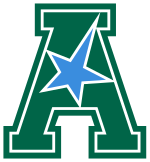Early history
The university was a charter member of the Southeastern Conference (SEC), formed in 1932. [6] Prior to this, they had competed in the Southern Conference. [7] During its time in the SEC, the men's tennis program won 18 conference championships, [7] while the football program won conference championships for the 1934, 1939, and 1949 seasons. [6] During the 1948 season, Tulane football led the SEC in home game attendance, with an average of 37,058 spectators per game. [7]
Athletics deemphasis and SEC departure
Starting in 1951, Rufus Carrollton Harris, the university's president, initiated a deemphasis of athletics. [7] That year, Harris reduced the number of football athletic scholarships from 100—an average amount in the SEC at the time—to 75. [7] Prior to the deemphasis, many football players studied physical education (PE) at Tulane, which did not require college athletes to pursue an academic major and allowed them to spend 50 hours per week on PE coursework. [7] However, Tulane under Harris reclassified PE as an academic minor, further requiring college athletes to pursue bachelor's degrees. [7] Salaries for coaches and athletic personnel were also decreased and limits were placed on coaches' ability to scout. [7]
This deemphasis caused Tulane to field a less competitive football program. [7] From 1952 to 1965, Tulane recorded a 37–95–8 record, averaging below three wins per season. [7] The football program had four head coaches during this time and only recorded two seasons with a winning record. [7] In conference play, the Green Wave recorded a 16–71–5 record, [7] and from 1957 to 1965, Tulane did not win more than one conference game per season. [6] In September 1963, the university announced that they would remain in the SEC while studying possible alternatives. [7] Around this time, there were rumors that Tulane would form a "Southern Ivy League" with schools such as Duke University, Rice University, and Southern Methodist University, though this never came to fruition. [7]
On December 31, 1964, Herbert E. Longenecker, Tulane's president and the vice president of the SEC, announced that the university would be leaving the conference in June 1966. [7] While Longenecker announced that the cost of the football program was not a factor in the decision to leave the SEC, the Tulane Hullabaloo reported in 1965 that the football program was losing the university roughly half a million dollars per year. [7] The Hullabaloo's sports editor Stuart Ghertner wrote that some Tulane fans thought the university was simply "saving face" by leaving, as it was possible that the university would have been expelled from the SEC the following year. [7] According to The Clarion-Ledger newspaper, one reason for the departure was the transition that Tulane had overtaken in the previous few years from a regionally renowned to a nationally renowned university, with the university believing that athletic independence would allow for more games across the country. [6] Tommy O'Boyle, the head coach of the football team at the time, said of the departure, "It sure can't do us any harm. Tulane is a national university. Now we can play a national schedule". [6]
Post-SEC departure
Following its departure, Tulane continued its in-state rivalry with the LSU Tigers, who had remained in the SEC. [7] In its first few years as an independent, the football program enjoyed an increase in attendance and recorded three winning seasons in seven years, with its first season as an independent being its first winning season in ten years. [7] However, increased costs associated with university athletics, such as Title IX compliance and increased salaries for coaches, hurt the athletics department, and its status as an independent damaged several longstanding conference rivalries and eliminated the possibility of competing for conference championships, which hurt public interest. [7]
In 1975, Tulane joined the Metro Conference for all sports except football. [7] From 1985 to 1989, the university did not have a basketball program, and the university nearly voted to end its football program in 1985. [7] In the late 1980s, Tulane expressed interest in rejoining the SEC, but the interest was not reciprocated by the conference, which was under the commissionership of Harvey Schiller. [6] However, the discussions led the SEC to pursue conference expansion, eventually leading to the admission of the University of Arkansas and the University of South Carolina into the SEC. [6] In 1995, the Metro Conference merged with the Great Midwest Conference to form Conference USA. [7] Tulane became a full member in this new conference for all sports, including football. [7] In 2014, the university left Conference USA and joined the American Athletic Conference. [7]








